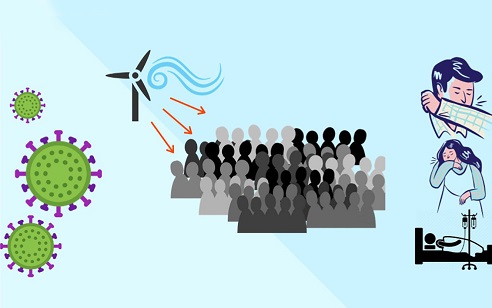BREAKING! Highly Pathogenic Avian Influenza Viruses Such As H5N1 Are Also Wind Borne And Can Be Transmitted Over Distances Of Up To 25 Km!
Nikhil Prasad Fact checked by:Thailand Medical News Team Apr 23, 2024 1 year, 8 months, 1 week, 9 hours, 36 minutes ago
H5N1 News: Highly Pathogenic Avian Influenza (HPAI) is a formidable challenge in the realm of poultry farming and public health globally. It represents not just a threat to animal populations but also carries significant risks of zoonotic transmission, potentially affecting human health. Amidst the myriad of transmission routes, the wind-borne spread of HPAI has emerged as a topic of interest and concern. This
H5N1 News report delves into the research conducted by Wageningen University in the Netherlands, which focuses on modeling the wind-borne spread of HPAI between farms during the notable 2003 epidemic. Many people are unaware that such highly pathogenic avian influenza viruses such as H5N1 can also be spread/transmitted by winds!
 Highly Pathogenic Avian Influenza Viruses Such As H5N1 Are Also
Highly Pathogenic Avian Influenza Viruses Such As H5N1 Are Also
Wind Borne And Can Be Transmitted Over Distances Of Up To 25 Km!
Context and Importance
The outbreak of HPAI, alongside other highly contagious viruses such as Classical Swine Fever Virus (CSFV) and Foot-and-Mouth Disease Virus (FMDV), presents substantial challenges to the livestock industry. The 2003 HPAI epidemic in the Netherlands serves as a stark reminder of the devastating impact such outbreaks can have. Beyond economic losses and animal welfare concerns, there are significant public health ramifications, including the risk of transmission to humans. Understanding the mechanisms of between-farm spread, particularly through indirect routes like wind-borne transfer, is paramount for devising effective control strategies and mitigating the impact of future outbreaks.
Analyzing the Wind-Borne Spread
The research undertaken at Wageningen University sought to develop a comprehensive model that quantifies the spread of contaminated farm dust between locations. This model accounts for various factors influencing transmission dynamics, including dust deposition, pathogen decay, and the infection process on exposed farms. By incorporating poultry- and avian influenza-specific parameters, the researchers were able to calculate the probability of between-farm transmission via the wind-borne route.
Model Development and Insights
The model developed by Wageningen University is rooted in a Gaussian Plume Model (GPM) framework, which is commonly used to analyze atmospheric dispersion phenomena. However, this adaptation goes beyond mere dispersion modeling; it incorporates crucial elements such as dust deposition processes and pathogen decay rates. These additions provide a more nuanced understanding of how contaminated farm dust, laden with HPAI virus particles, can be transported and deposited over varying distances.
The insights gained from this modeling effort are significant. It was observed that while wind-borne transmission could indeed contribute substantially to short-distance spread (up to 25 km), it alone is insufficient to fully explain the observed transmission patterns during the 2003 epidemic. This indicates the presence of other transmission pathways, necessita
ting a holistic approach to disease control and prevention.
Discussion and Sensitivity Analysis
The research team conducted a thorough sensitivity analysis to explore the impact of various parameters on wind-borne transmission probabilities. Factors such as wind speed, settling velocity of particles, vertical eddy diffusivity, effective release height, pathogen decay rate, and the within-flock basic reproduction ratio were scrutinized. This analysis revealed the intricate interplay between these variables and their influence on the dispersal and deposition of contaminated dust particles.
Of particular note were the findings related to particle deposition and pathogen decay. These factors were found to have a significant effect on ground-level air-borne dust concentrations, especially over longer distances from the source farm. Such insights underscore the importance of considering not just dispersal mechanisms but also the survival characteristics of the virus strain in question when assessing the risk of wind-borne transmission.
Implications and Future Directions
The conclusion that wind-borne transmission alone cannot account for all observed infections during the 2003 epidemic has profound implications. It suggests the existence of supplementary transmission mechanisms, possibly involving multi-stage indirect routes. This highlights the need for continued research into alternative models for indirect transmission, including the role of fomites, human vectors, and other potential carriers of infectious material.
Furthermore, the modeling framework developed by Wageningen University has broader applicability beyond HPAI. Similar approaches can be adopted to study the wind-borne spread of other livestock diseases, emphasizing the universal importance of factors such as particle deposition, pathogen survival, and environmental conditions in shaping disease transmission dynamics.
Conclusion
In conclusion, while the wind-borne spread of HPAI can contribute significantly to localized transmission events, it is just one piece of the larger puzzle. The research conducted by Wageningen University sheds light on the complexities of modeling such transmission routes and underscores the need for a multifaceted approach to disease control and prevention. By gaining a deeper understanding of the various transmission pathways and their interactions, we can better equip ourselves to mitigate the impact of highly pathogenic viruses on both animal and human populations.
The study findings were published in the peer reviewed journal: PLOS One.
https://journals.plos.org/plosone/article?id=10.1371/journal.pone.0031114
For the latest
H5N1 News, keep on logging to Thailand Medical News.
